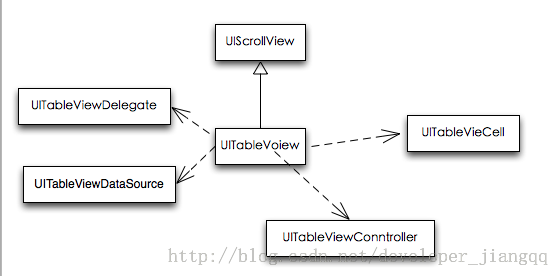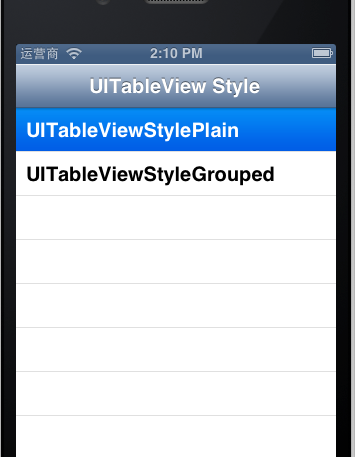上一篇初步学习了一下表视图(UITableView)的基本概念内容(点击进入),今天就表视图的其他知识进行学习,并且实现表视图。
(一)UITableView的相关类解析:
首先我们来看张类的结构图:

1:表视图(UITableView)是继承自UIScrollView,这样就可以使得我们的表视图可以实现上下的滚动。
2:同时表视图(UITableView),还有两个委托①:UITableViewDelegate委托协议,一般我们用来处理表视图的基本样式(例如:单元格的高度等)还有去捕捉选中单元格的事件。②:UITableViewDataSource委托协议,必要要去实现该协议的数据源方法,来完成表视图的数据配置。
3:UITableViewController:是表视图(UITableView)的控制器类。
4:UItableViewCell:是单元格类.
(二):数据源协议和委托源协议介绍:
1:UITableViewDataSource协议:我们去实现其中的方法,来完成我们的表视图的数据配置,从而来显示表视图。其中我们必须要去实现的两个方法如下:
//进行返回每个section(节)中单元格的数量 - (NSInteger)tableView:(UITableView *)tableView numberOfRowsInSection:(NSInteger)section; // Row display. Implementers should *always* try to reuse cells by setting each cell's reuseIdentifier and querying for available reusable cells with dequeueReusableCellWithIdentifier: // Cell gets various attributes set automatically based on table (separators) and data source (Accessory views, editing controls) // 为表视图中的单元格创建数据 - (UITableViewCell *)tableView:(UITableView *)tableView cellForRowAtIndexPath:(NSIndexPath *)indexPath;
除了以上的两个必须实现的方法,还有一些以下的可选实现方法:
// 返回section(节)的个数 - (NSInteger)numberOfSectionsInTableView:(UITableView *)tableView; // Default is 1 if not implemented //返回section(节)头的标题 - (NSString *)tableView:(UITableView *)tableView titleForheaderInSection:(NSInteger)section; // fixed font style. use custom view (UILabel) if you want something different // 返回section(节)尾的标题 - (NSString *)tableView:(UITableView *)tableView titleForFooterInSection:(NSInteger)section; - (BOOL)tableView:(UITableView *)tableView canEditRowAtIndexPath:(NSIndexPath *)indexPath; - (BOOL)tableView:(UITableView *)tableView canMoveRowAtIndexPath:(NSIndexPath *)indexPath; - (NSArray *)sectionIndexTitlesForTableView:(UITableView *)tableView; // return list of section titles to display in section index view (e.g. "ABCD...Z#") - (NSInteger)tableView:(UITableView *)tableView sectionForSectionIndexTitle:(NSString *)title atIndex:(NSInteger)index; - (void)tableView:(UITableView *)tableView commitEditingStyle:(UITableViewCellEditingStyle)editingStyle forRowAtIndexPath:(NSIndexPath *)indexPath; - (void)tableView:(UITableView *)tableView moveRowAtIndexPath:(NSIndexPath *)sourceIndexPath toIndexPath:(NSIndexPath *)destinationIndexPath;
2:UITableViewDelegate:协议可以用来设定表视图中的节头与节尾 同时还可以去响应一些点击事件,主要的一些方法如下:
- (UIView *)tableView:(UITableView *)tableView viewForHeaderInSection:(NSInteger)section; // custom view for header. will be adjusted to default or specified header height - (UIView *)tableView:(UITableView *)tableView viewForFooterInSection:(NSInteger)section; // custom view for footer. will be adjusted to default or specified footer height - (NSIndexPath *)tableView:(UITableView *)tableView willSelectRowAtIndexPath:(NSIndexPath *)indexPath; - (void)tableView:(UITableView *)tableView didSelectRowAtIndexPath:(NSIndexPath *)indexPath;
更多方法可以去官网UITableView进行查询。
(三) 表视图(UITableView)的一些常用方法和属性:
1:常用属性:
①:@property(nonatomic) UITableViewCellSeparatorStyle separatorStyle; 默认为UITableViewCellSeparatorStyleSingleLine
②:@property(nonatomic,retain) UIColor *separatorColor; 默认为:the standard separator gray
③:@property(nonatomic,retain) UIView *tableHeaderView; 头部视图
④:@property(nonatomic,retain) UIView *tableFooterView; 尾部视图
⑤:@property(nonatomic) CGFloat rowHeight; // 单元格高度
⑥:@property(nonatomic) CGFloat sectionHeaderHeight; // 头部行高
⑦:@property(nonatomic) CGFloat sectionFooterHeight; //尾部行高
⑧:@property(nonatomic,readwrite,retain) UIView *backgroundViewNS_AVAILABLE_IOS(3_2);
⑨:@property(nonatomic,readonly) UITableViewStyle style;
2:常用方法:
①:- (void)reloadData; // reloads everything from scratch. redisplays visible rows. because we only keep info about visible rows, this is cheap. will adjust offset if table shrinks 刷新单元格的数据
②:- (void)reloadSectionIndexTitlesNS_AVAILABLE_IOS(3_0); // reloads the index bar.
③:- (NSInteger)numberOfSections; //返回节的数量
④:- (NSInteger)numberOfRowsInSection:(NSInteger)section;//返回每个节的单元格的数量
⑤:- (CGRect)rectForSection:(NSInteger)section; // includes header, footer and all rows
⑥:- (CGRect)rectForHeaderInSection:(NSInteger)section;
⑦:- (CGRect)rectForFooterInSection:(NSInteger)section;
⑧:- (CGRect)rectForRowAtIndexPath:(NSIndexPath *)indexPath;
⑨:- (NSIndexPath *)indexPathForRowAtPoint:(CGPoint)point; // returns nil if point is outside table
⑩:- (NSIndexPath *)indexPathForCell:(UITableViewCell *)cell; //返回指定单元格的NSIndexPath实例
十一:- (NSArray *)indexPathsForRowsInRect:(CGRect)rect; //返回指定范围的NSIndexPath实例数组
十二:- (UITableViewCell *)cellForRowAtIndexPath:(NSIndexPath *)indexPath; // returns nil if cell is not visible or index path is out of range //返回指定NSIndexPath实例的单元格实例
十三:- (NSArray *)visibleCells; //返回可见的单元格的数组
十四- (NSArray *)indexPathsForVisibleRows; //返回可见单元格的NSIndexPath实例数组
十五:- (UITableViewHeaderFooterView *)headerViewForSection:(NSInteger)sectionNS_AVAILABLE_IOS(6_0);
十六:- (UITableViewHeaderFooterView *)footerViewForSection:(NSInteger)sectionNS_AVAILABLE_IOS(6_0);
十七:- (void)scrollToRowAtIndexPath:(NSIndexPath *)indexPath atScrollPosition:(UITableViewScrollPosition)scrollPosition animated:(BOOL)animated; //滑动到指定的位置,并且可以加上动画效果
十八:- (void)scrollToNearestSelectedRowAtScrollPosition:(UITableViewScrollPosition)scrollPosition animated:(BOOL)animated;
(四)例子实现表格布局
简单的来说:是以下几个步骤:1.配置数据源,2.实现数据源方法,3.设置代理方法。下面来看实例
// // ZTTRootViewController.m // UITableViewDemo1 // // Created by 江清清 on 14-3-19. // Copyright (c) 2014年 江清清<<a>Http://www.0513.it/</a>中天科技软件技术股份有限公司>. All rights reserved. // #import "ZTTRootViewController.h" #import "ZTTDetailsViewController.h" #define kDeviceHeight [UIScreen mainScreen].bounds.size.height @interface ZTTRootViewController () @end @implementation ZTTRootViewController - (id)initWithNibName:(NSString *)nibNameOrNil bundle:(NSBundle *)nibBundleOrNil { self = [super initWithNibName:nibNameOrNil bundle:nibBundleOrNil]; if (self) { self.title=@"UITableView Style"; } return self; } -(void)loadView{ UIView *view=[[UIView alloc]initWithFrame:[UIScreen mainScreen].applicationFrame]; //[view setBackgroundColor:[UIColor redColor]]; self.view=view; [view release]; //开始进行配置数据源 self.listArray=@[@"UITableViewStylePlain",@"UITableViewStyleGrouped"]; _tableView=[[UITableView alloc]initWithFrame:CGRectMake(0, 0, 320,kDeviceHeight-20-44) style:UITableViewStylePlain]; //实现数据源方法 [_tableView setDataSource:self]; //设置点击事件 代理方法 [_tableView setDelegate:self]; [self.view addSubview:_tableView]; } - (void)viewDidLoad { [super viewDidLoad]; // Do any additional setup after loading the view. } - (void)didReceiveMemoryWarning { [super didReceiveMemoryWarning]; // Dispose of any resources that can be recreated. } #pragma mark- tableview date source /* * 一个selection中又多少个单元格 */ - (NSInteger)tableView:(UITableView *)tableView numberOfRowsInSection:(NSInteger)section { return [_listArray count]; } // indexPath //创建单元格 - (UITableViewCell *)tableView:(UITableView *)tableView cellForRowAtIndexPath:(NSIndexPath *)indexPath{ static NSString *cellInditifier=nil; // 创建单元格对象 UITableViewCell *cell=[tableView dequeueReusableCellWithIdentifier:cellInditifier]; if(cell ==nil){ cell=[[[UITableViewCell alloc]initWithStyle:UITableViewCellStyleDefault reuseIdentifier:cellInditifier]autorelease]; } NSString *text=[self.listArray objectAtIndex:indexPath.row]; cell.textLabel.text=text; return cell; } // 表视图中有几个selection - (NSInteger)numberOfSectionsInTableView:(UITableView *)tableView{ return 1; } // 选中单元格的方法 - (void)tableView:(UITableView *)tableView didSelectRowAtIndexPath:(NSIndexPath *)indexPath{ NSLog(@"didSelect"); //进行跳转到相应的页面 ZTTDetailsViewController *detailsVC=[[ZTTDetailsViewController alloc]init]; detailsVC.isPlain=indexPath.row==0?YES:NO; [self.navigationController pushViewController:detailsVC animated:YES]; [detailsVC release]; } -(void)dealloc{ [_tableView release]; _tableView=nil; [super dealloc]; } @end
运行截图如下:

3:上面的代码例子是一般的表格,如果我们要表格中加入表头(header)和表尾(footer)话,我们需要实现以下两个数据源方法:
- (NSString *)tableView:(UITableView *)tableView titleForHeaderInSection:(NSInteger)section; // fixed font style. use custom view (UILabel) if you want something different - (NSString *)tableView:(UITableView *)tableView titleForFooterInSection:(NSInteger)section;
运行截图如下:
